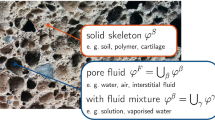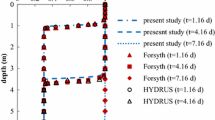Summary
This paper presents a general model for the analysis of coupled thermo-hydro-mechanical problems in porous media with possible pollutant transport. The governing equations are described and discrete solution techniques using the finite element method in space and finite differences in time are shown. Emphasis is put on a direct solution procedure, where the coupled system of equations is solved without use of matrix partitioning. Both the Newton-Raphson method and fixed point method are employed.
Application examples involving pollutant transport, heat and mass transfer in partially saturated geomaterials, dynamic strain localization and durability of concrete show the range of applicability of this model in the field of evironmental engineering.
Similar content being viewed by others
References
Hutter, K. (1993), “Thermo-mechanically coupled ice-sheets response-cold, polythermal, temperate”,Journal of Glaciology, Vol.39, 65–86.
Gambolati, G., Verri, G.,Proc. Symposium on Advanced Methods for Groundwater Pollution Control, CISM, Springer Verlag, to appear.
Schrefler, B.A., D’Alpaos, L., Zhan, X.Y. and Simoni, L. (1994), “Pollutant transport in deformingporous media”,Eur. J. Mech., A/Solids,13, n.4-suppl., 175–194.
Manassero, M. and Shakelford, C.D. (1994), “The role of diffusion in contaminant migration through soil barriers”,Rivista Italiana di Geotecnica,1, 5–23.
Chapman N.A. and McKinley, I.G. (1987),The Geological Disposal of Nuclear Waste, J. Wiley & Sons, Chichester.
Olivella, S., Carrera, J., Gens, A. and Alonso, E.E. (1994), “Non-isothermal multiphase flow of brine and gas through saline media”, inTransport in Porous Media,15, pp. 271–293.
Olivella, S., Gens, A., Alonso, E.E. and Carrera, J. (1992), “Constitutive modelling of porous salt aggregate”, Proceedings of theIV Int. Symps. on Num. Models in Geomechanics, A.A. Balkema, Roterdam, 179–189.
Saetta, A., Schrefler, B.A. and Vitaliani, R. (1993), “The carbonation of concrete and the mechanism of moisture, heat and carbon dioxide flow through porous materials”,Cement and Concrete Research,23, 761–772.
de Boer, R., Ehlers, W., Kowalski, S. and Plischka, J. (1991), “Porous media, a survey of different approaches”,Forschungsbericht aus dem Fachbereich Bauwesen,54, Universität-Gesamthochschule Essen.
Bowen, R.M. (1980), “Incompressible porous media models by use of the theory of mixtures”,Int. J. Engng. Sci.,18, 1129–1148.
Williams, W.O. (1978), “Constitutive equations for flow of an incompressible viscous fluid through a porous medium”,Quarterly of Applied Mathematics, 255–267, October.
Biot, M.A. (1935), “Le problème de la consolidation des matieres argilleuses sous une charge”,Ann. Soc. Sci. Bruxelles, série B 55, 110–113.
Biot, M.A. (1941), “General theory of three-dimensional consolidation”,J. Appl. Phys.,12, 155–164.
Coussy, O. (1991),Mécanique des milieux poreux, Editions Techniq, Paris.
Hassanizadeh, M. and Gray W.G. (1979), “General conservation equations for multiphase systems: 1 Averaging procedure”,Adv. Water Resources,2, 131–144.
Hassanizadeh, M. and Gray W.G. (1979), “General conservation equations for multiphase systems: 2. Mass momenta, energy and entropy equations”,Adv. Water Resources,2, 191–203.
Hassanizadeh, M. and Gray W.G. (1980), “General conservation equations for multiphase systems: 3. Constitutive theory for porous media flow”,Adv. Water Resources,3, 25–40.
Hassanizadeh, S.M. (1986), “Derivation of basic equations of mass in porous media, Part. 1 Macroscopic balance laws”,Adv. Water Resources, Vol.9, 196–206.
Hassanizadeh, S.M. (1986), “Derivation of basic equations of mass in porous media, Part. 2. Generalized Darcy’s law and Fick’s law”,Adv. Water Resources, Vol.9, 207–222.
Bear, J. and Bachmat, Y., “Transport phenomena in porous media—Basic equations”, fromFundamentals of Transport Phenomena in Porous Media, (Bar, J. and Corapcioglu. M. Y. eds.), Nato ASI Series, Nijhoff.
Schrefler, B.A., Simoni, L., Xikui, L. and Zienkiewicz, O.C. (1990), “Mechanics of partially saturated porous media”, fromNumerical Methods and Constitutive Modelling in Geomechanics, C.S. Desai and G. Gioda, eds., Springer Verlag, Wien, 169–209.
Lewis, R.W. and Schrefler, B.A., “The Finite Element Method in the Static and Dynamic Deformation and Consolidation of Porous Media”, to appear in Wiley & Sons.
Malvern, L.E. (1969),Introduction to the Mechanics of a Continuous Medium, Prentice Hall, Englewood Cliffs, NJ.
Chen, W.F. and Tsui, Y. (1992), “Limitations to the large strain theory”,Int. J. Num. Meth. Eng.,33, 101–114.
Molenkamp, F. (1986), “Limits to the Jaumann stress rate”,Int. J. Num. Anal. Meth. Geomech.,10, 151–176.
Gray, W.G. and Hassanizadeh S.M. (1991), “Unsaturated flow theory includinginterfacial phenomena”,Water Resour Res., Vol.27, 1855–1863.
Gray, W.G., and Hassanizadeh, S.M. (1991), “Paradoxes and realities in unsaturated flow theory”,Water Resour. Res., Vol.27, 1847–1854.
Ehlers, W. (1989), “Poröse Medien, ein kontinuumsmechanisches Modell auf der Basis der Mischungstheorie”,Forschungsbericht aus dem Fachbereich Bauwesen,47, Universität Gesamthochschule Essen.
Coleman, B.D., and Noll, W. (1963), “The thermodynamics of elastic materials with heat conduction and viscosity”,Arch. Ration. Mech. Anal.,13, 168–178.
Bishop, A.W. (1959), “The principle of effective stress”,Teknisk Ukeblad,39, 859–863.
Biot, M.A., and Willis, P.G. (1957), “The elastic coefficients of the theory of consolidation”,J. Appl. Mech.,24, 594–601.
Baggio, P., Bonacina, C. and Strada, M. (1993), “Trasporto di calore e di massa nel calcestruzzo cellulare”,La Termotecnica,45, 53–60.
Baggio, P., Majorana, C.E. and Schrefler, B.A. (1995), “Thermo-hygromechanical analysis of concrete”,I.J.N.M.F.,20, 573–595.
Schrefler, B.A., Zhan, X. and Simoni, L. (1995), “A coupled model for water flow, airflow and heat flow in deformable porous media”, to appear in I.J.N.M. Heat and Fluid Flow.
Zienkiewicz, O.C. and Taylor, R.L. (1989),The Finite Element Method, McGraw-Hill, London.
Lewis, R.W. and Schrefler, B.A. (1987),The Finite Element Method in the Deformation and Consolidation of Porous Media, Wiley and Sons, Chichester.
Norris, V. (1980), “The elastoplastic analysis of soil consolidation with special reference to kinematic hardening”,Ph.D. Thesis, University College of Swansea.
Park, K.C. and Felippa, C.A. (1983), “Partitioned analysis of coupled systems”, from T. Belytschko and T.R.J. Hughes (eds),Computational Methods for Transient Analysis, Elsevier Science Publishers B.V.
Turska, E., Wisniewski K. and Schrefler, B.A. (1994), “Error propagation of staggered solution procedures for transient problems”,Com. Methods in Appl. Mech. and Eng.,114, 177–178.
Turska, E. and Schrefler, B.A. (1993), “On convergence condition of partitioned solution procedures for consolidation problems”,Com. Methods in Appl. Mech. and Eng.,106, 51–63.
Gawin, D., Baggio, P. and Schrefler, B.A. (1995), “Coupled heat, water and gas flow in deformable porous media”,I.J.N.M.F.,20, 969–987.
Marchuk, G.I. (1975),Methods of Numerical Analysis, Springer Verlag, New York.
Forsyth, P.A. and Simpson, R.B. (1991), “A two phase, two component model for natural convection in a porous medium”,Int. J. Num. Meth. Fluids,12, 655–682.
Schrefler, B.A. and Zhan, X. (1993), “A fully coupled model for water flow and airflow in deformable porous media”,Water Resour. Res.,29, 155–167.
Brooks, R.N. and Corey, A.T. (1966), “Properties of Porous Media affectingfluid flow”,J. Irrig. Drain Div. Am. Soc. Civ. Eng.,92(IR2), 61–68.
Daksanamurthy, V. and Fredlund, D.G. (1981), “A mathematical model for predictingmoisture flow in an unsaturated soil under hydraulic and temperature gradients”,Water Resour. Res.,17, 714–722.
Gawin, D. and Schrefler, B.A., “Thermo-hydro-mechanical analysis of partially saturated porous materials”, to appear in Engineering Computations.
Matticchio, B., D’Alpaos, L. and Lippe, E. (1991), “Indagine sperimentale sul movimento di un inquinante in colonna di sabbia parzialmente satura”, CNR, Programma speciale VAZAR, Publ. n. 260, Venice.
Parker, J.C. (1989), “Multiphase flow and transportation in porous media”,Rev. Geoph.,27, 311–328.
Abriola, L.M. and Pinder, G.F. (1985), “A multiphase approach to modeling of porous media contamination by organic compounds 1. Numerical simulation”,Water Resour. Res.,21, 19–26.
Corapcioglu, M.Y. and Baehr, A.L. (1987), “A compositional multiphase model for groundwater contamination by petroleum produces. 1. Theoretical considerations”,Water Resour. Res.,23, 191–200.
Kueper, B.H. and Frind, E.O. (1989), “The behaviour of dense nonaqueous phase liquid contaminants in heterogeneous porous media”, inContaminant Transport on Groundwater, Kobus H.E. & Kinzelbach W. (eds.), 381–387, Balkema, Rotterdam.
Mendoza, C.A. and Frind, E.O. (1990), “Advective-dispersive transport of dense organic vapours in the unsaturated zone 1. Model development”,Water Resour. Res.,226, 379–387.
Loret, B. and Prevost, J.H. (1991), “Dynamic strain localization in fluid saturated porous media”,J. Eng. Mech.,11, 907–922.
Schrefler, B.A., Majorana, C. and Sanavia, L. (1995), “Shear band localization in saturated porous media”,Archives of Mechanics,47, 577–599.
Zienkiewicz, O.C., Xie, Y.M., Schrefler, B.A., Ledesma, A. and Bicanic, N. (1990), “Static and dynamic behaviour of soils: a rational approach to quantitative solutions. II semi-saturated problems”,Proc. R. Soc. Land.,A 429, 311–321.
Meroi, E.A., Schrefler, B.A. and Zienkiewicz, O.C. (1995), “Large strain static and dynamic semisaturated soil behaviour”,Int. Num. Anal. Meth. Geomech.,19, 2, 81–106.
Zienkiewicz, O.C., Chan, A.H.C., Pastor, M., Paul, D.K. and Shiomi, T. (1990), “Static and dynamic behaviour of soils: a rational approach to quantitative solutions. I fully saturated problems”,Proc. R. Soc. London,A 429, 285–309.
Cheng, W.F. and Tsui, Y. (1992), “Limitations to the large strain theory”,Int. J. Num. Meth. Eng. 33, 101–114.
Molenkamp, F. (1986), “Limits to the Jaumann stress rate,”Int. J. Num. Anal. Meth. Geomech.,10, 151–176.
Bolzon, G., Schrefler, B.A. and Zienkiewicz, O.C., “Elastoplastic soil constitutive laws generalized to partially saturated states”, to appear in Geotechnique.
Xie, Y.M. (1990), “Finite Element solution and adaptive analysis for static and dynamic problems of saturated-unsaturated porous media”,Ph. D. Thesis, Department of Civil Engineering, Swansea University, UK.
Safai, N.M. and Pinder, G.F. (1979), “Vertical and horizontal land deformation in a desaturating porous medium”,Adv. Water Resour.,2, 19–25.
RILEM (1976),International symposium on carbonation of concrete, Cem. Concr. Ass.
RILEM (1984),Seminar on the durability of concrete structure under normal outdoor exposure, 26th–29th March, Hannover.
Tuutti, K. (1982), “Corrosion of steel in concrete”,Swedish Cement and Concrete Research Institute, Stockholm.
Saetta, A.V., Schrefler, B.A. and Vitaliani, R., “2-D model for carbonation and moisture/heat flow in porous materials”, to appear inCement and Concrete Research.
Houst, Y. and Wittmann, F.H. (1989), “Diffusion de gaz et durabilité du béton armé”, IABSE Symposium,Durability of Structures, pp. 139–144, Lisbon.
Houst, Y. and Wittmann, F.H. (1989), “Retrait de carbonatation”, IABSE Symposium,Durability of Structures, pp. 255–260, Lisbon.
Bazant, Z.P. and Najjar, L.J. (1972), “Nonlinear water diffusion in nonsaturated concrete”,Materials and Structures, (RILEM, Paris), vol.5, n. 25, pp. 3–20.
Bazant, Z.P., Dougill, J.W., Huet, C., Tsubaki, T. and Wittmann, F.H. (1988), “Materials model for structural creep analysis”, inMathematical Modelling of Creep and Shrinkage of Concrete, ed. Z.P. Bazant, 99–216.
Saetta, A.V., Scotta, R.V. and Vitaliani, R.V. (1993), “Analysis of chloride diffusion into partially saturated concrete”,ACI Materials Journal,90, Nr. 5, 441–451.
Author information
Authors and Affiliations
Rights and permissions
About this article
Cite this article
Schrefler, B.A. F.E. in environmental engineering: Coupled thermo-hydro-mechanical processes in porous media including pollutant transport. ARCO 2, 1–54 (1995). https://doi.org/10.1007/BF02736173
Received:
Issue Date:
DOI: https://doi.org/10.1007/BF02736173




